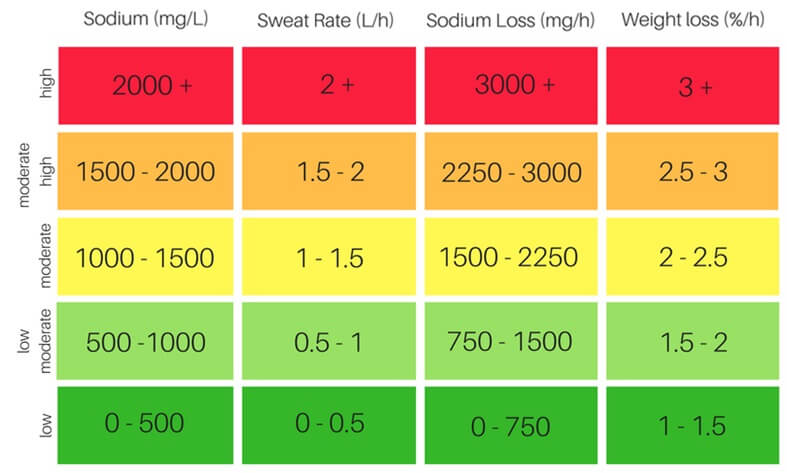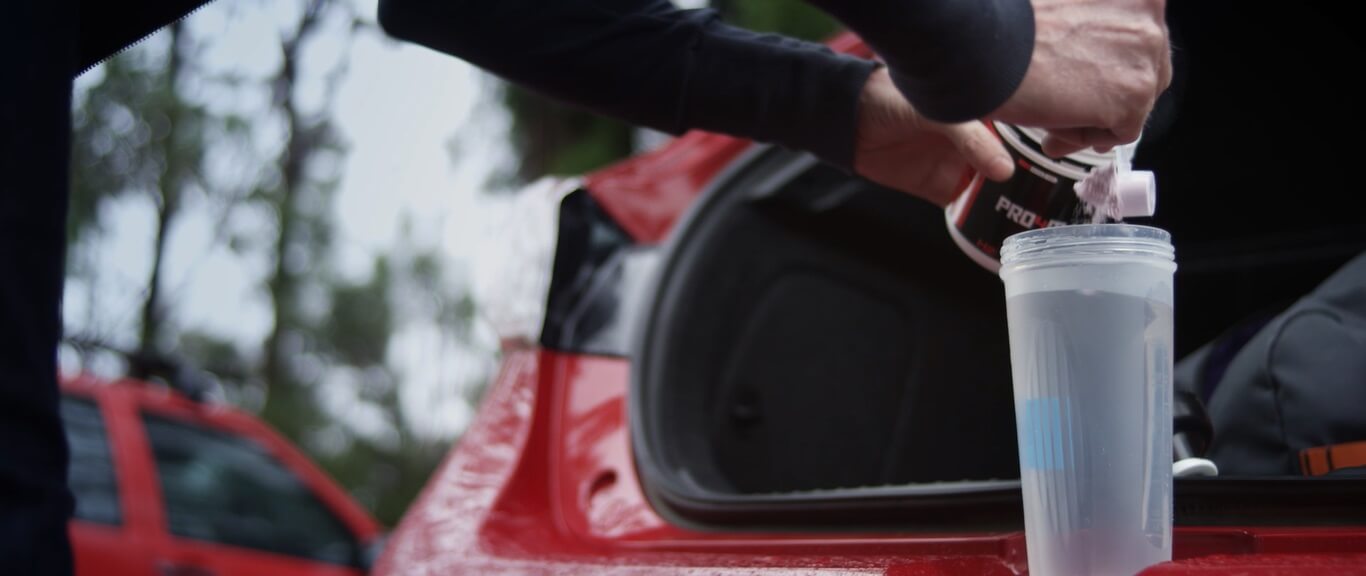Sweat testing is a procedure in which your sweat is collected and analysed to find the quantity of certain electrolytes per litre of sweat. This process requires your sweat samples to be analysed through a process called ion chromatography. Once your sweat samples has been analyzed and your results found, these numbers will be combined with your sweat rate and body weight to calculate your individual sweat testing results.

UNDERSTANDING YOUR RESULTS:
Sodium (mg/L)
This figure is the quanity of sodium that is within every litre of your sweat. It is measured in milligrams per litre
Sweat Rate (L/h)
This figure is the amount of sweat in litres you lose per hour. This is calculated by taking your pre testing weight minus your post testing weight. The difference in weight is then converted from kg to litres at the ratio of 1:1 (1kg = 1Litre). We can use this figure to muliply it over the number of hours your are going to race for to give an indication of the total amount of fluid you are going to lose.
Sodium Loss (mg/h)
This figure is calculated by multiplying your sodium (mg/L) by your sweat rate (L/h). This is the most important figure as it gives us the total amount of sodium loss during the testing period.
Weight Loss (%/h)
This figure is calculated by converting your pre and post testing weight difference into a percentage. This allows us to assess your sweat rate relative to your current weight and its possible effect. For example, there is a big difference between an athlete that losses 2L/h of sweat, if they are 50kg (4%) compared to 100kg (2%).
WHAT ARE ELECTROLYTES AND WHY ARE THEY IMPORTANT?
Electrolytes are naturally occurring essential minerals that control the movement of water within the body, maintain normal cellular activities and are vital for sending electrical signals from the brain to nerves that activate muscles to perform mechanical functions. When the body loses fluid and electrolytes, both must be replaced for the body to rehydrate, retain fluid and return to efficient functioning before heat stress illness sets in.
Drinking water alone does not optimally replace the lost fluids. Drinks with electrolytes increase water retention by 25% compared with drinking water alone, assisting you to avoid dehydration and maintaining your hydration & performance.
Sodium is the key electrolyte lost in sweat, which is why we focus on sodium to give us an indication of your electrolyte levels in sweat. The other common electrolytes lost in sweat are potassium, magnesium and calcium.
WHAT DO MY RESULTS MEAN:
Your results will give you an insight into your individual physiology and how your body reacts under endurance stress. The most important figures to focus on is your Sodium Loss (mg/h) & Weight Loss (%/h). These figure will show you the total amount of sodium you lose per hour & your total body weight loss through fluids, which is vital to know if you are trying to maximize your performance or resolve an issues associated with dehydration or low sodium levels.
Low level
If your results fall within the low level, then it’s likely you do not suffer from symptoms associated with dehydration or low sodium level and that if you do have symptoms, then they are more likely to be causes by other issues. It is still worth trying to increase your fluid and electrolyte intake, but if your symptoms continue, then you need to look for alternative causes.
Low moderate – moderate – moderate high levels
If your results fall within the low moderate – moderate – moderate high levels, then you need to start to consider actively planning your nutrition to ensure you are replacing your lost fluids and electrolyte (sodium) during exercise. Your likelihood of suffering from dehydration and low sodium levels increase as you move from the low moderate to the moderate high level. If you suffer from symptoms associated with dehydration or low sodium levels, then you should look to replace at least 25% of your totals to prevent your symptoms. If you continue to suffer your symptoms, then you need to gradually increase the amount you replace. Ensure you trial this in training to ensure your body can comfortably consume and absorb this quantity without resulting in gastro intestinal upsets.
High levels
If your results fall within the high level, then you are in the most vulnerable category of athletes and you will certainly suffer from symptoms of dehydration, low sodium and substantial performance reductions during warmer conditions over long periods of time. Not only do you need to try to replace the greatest quantity of fluids and electrolytes that you can (aim to replace 25 – 50%), but you might need to race at lower intensities and be selective in the races you choose by looking to race in cooler conditions as this will allow you to perform at a higher intensity.
When you consume fluids and electrolytes during a race or training session, you will find you will be able to consume approximately 50% more while riding a bike compared to running.

HOW TO INCREASE YOUR SODIUM LEVELS:
Pro4mance has multiple options to help replace lost electrolytes during exercise. Even though all the Pro4mance products contain multiple types of electrolytes, we will focus on replacing the sodium loss during exercise
Prodrate Electrolyte Drink per scoop: 227.5mg of sodium
Produrance Endurance Drink per scoop: 183mg of sodium
Produrance Energy Gels per gel: 184mg of sodium
| Prodrate Electrolyte Drink | Produrance Endurance Drink | Produrance Energy Gel |
| Sodium – 227.5mg Chloride – 225.5mg Potassium – 97.5mg Phosphorus – 75mg Magnesium – 17.5mg Calcium – 33mg |
Sodium – 183mg Chloride – 180mg Potassium – 78mg Phosphate – 120mg Magnesium – 10mg |
Sodium – 184mg Chloride – 180mg Potassium – 78mg Phosphate – 119mg Magnesium – 10mg |
| Total = 676mg per scoop | Total = 571mg per scoop | Total = 571mg per scoop |
How to consume 450mg of sodium per hour:
2 x scoops of Prodrate in 750-1000ml of water
= 455mg of sodium per hour
2.5 x scoops of Produrance Endurance Drink in 750-1000ml of water
= 457.5mg of sodium per hour
How to consume 750mg of sodium per hour:
1 x scoop of Prodrate in 750 – 1000ml of water
3 x Produrance Energy Gel
= 227.5 + 552mg = 779.5mg of sodium per hour
3 x scoops of Produrance Endurance Drink in 750ml- 1000ml of water
1 x scoop of Prodrate in the same bottle
= 549mg + 227.5mg = 776.5mg of sodium per hour
How to consume 1000mg of sodium per hour:
3 x scoops of Prodrate in 750-1000ml of water
2 x Produrance Energy Gels
= 682.5mg + 368mg = 1050.5mg of sodium per hour
2 x scoops of Prodrate in 750-1000ml of water
3 x Produrance Energy Gel
= 455mg + 552mg = 1007mg of sodium per hour
How to consume 1200mg of sodium per hour:
3 x scoops of Prodrate in 750-1000ml of water
3 x Produrance Energy Gels
= 682.5mg + 549mg = 1231.5mg of sodium per hour
How to consume 1450mg of sodium per hour:
4 x scoops of Prodrate in 750-1000ml of water
3 x Produrance Energy Gels
= 682.5mg + 549mg = 1459mg of sodium per hour
FAQ:
How much fluids can I drink during a race/training session?
Most athletes cannot drink more then 1.2 – 1.5L of fluids per hour while riding a bike, when they are running, this figure reduces to 600 – 800ml of fluids per hour. You need to find the volume of fluids that you can comfortably consume and carry on your bike/run. It is very important that you train your stomach to find out how much fluids you can comfortably consume. If you try to drink too much, you will cause gastrointestine upsets so it is important you trial this during a training session rather then a race.
Do I need to consume the same amount of fluids and electrolytes while running compared to cycling?
Most athletes would find it physically impossible to consume the same amounts of fluids and electrolytes while running compared to when they are riding a bike. As a general rule, we recommend consuming 50% of the fluids and electrolytes you would consume on the bike while you are running. This will ensure you do not cause any gastro intestinal upsets or electrolyte inbalances within your body.
Why shouldn’t I just drink water to improve my hydration levels?
Consuming water alone, actually leads to further electrolyte loss in your body. When you drink plain water, your body will draw electrolytes away from within your body into your interstines to balance out the electrolyte difference between your the body and the plain water. This will cause a negative effect on your electrolyte levels result in further dehydration.
Can I just consume large quantities of electrolytes without water?
It is not recommended to consume electrolytes without water, this is because both are required to rehydrate your body. If you consume electrolytes alone, it will actually further dehydrate your body as it will draw fluid out of your cells into your intestines which will results in further dehydration and bloating.
What can I do to maximise my hydration and electrolyte levels before a race?
It is recommended that you consume 1-2L of Prodrate (2-3 scoops per Litre) in the 3 days prior to your race. This will ensure you maximise your electrolyte levels, which in turn, holds the fluids within your body to maximise your hydration levels.
Can my sweat rate change?
Yes, your sweat rate will depend on environmental conditions (e.g. temperature and humidity) and your exercise intensity. When your intensity or the temperture/humidity increases, your sweat rate will also increase.
What are the symptoms of Dehydration & Low Sodium Levels in the body?
● Tiredness and weakness
● Loss of power & speed
● Loss of energy
● Increased heart rate
● Nausea and vomiting
● Muscle spasms and cramps
● Loss of appetite
● Increased thirst
● Craving salty foods
● Dizziness or fainting
● Slurred speech
● Blurred vision
● Headaches
● Confusion